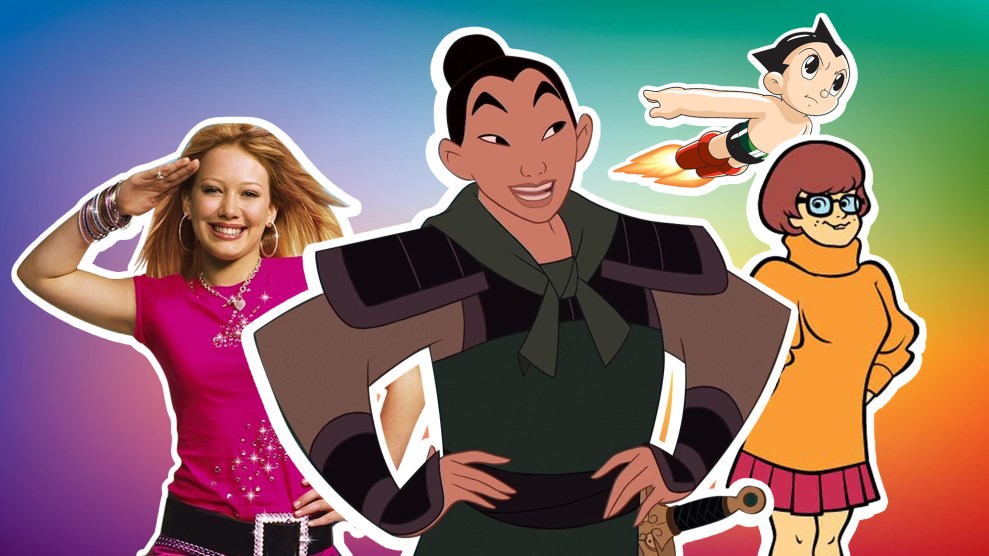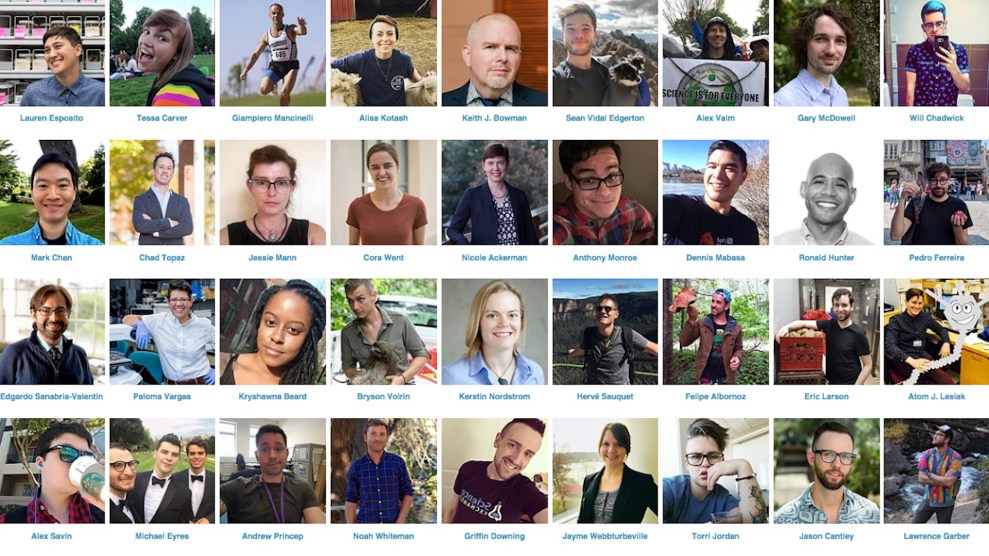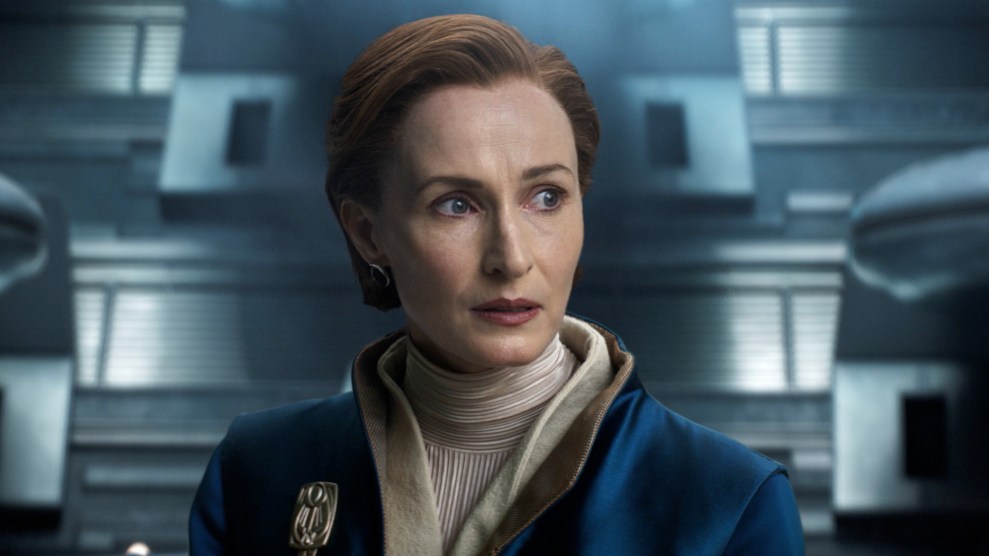
Mother Jones; Sullivan Entertainment; New Line Cinema
At around eight years old, when Anna Swartz first saw the made-for-TV movie Au Pair, she got a “painful good feeling” in her chest. At the time, she didn’t know if the emotion was brought on by the movie itself or its lead actress, Heidi Lenhart. “She had these glasses, and she wore these little ’90s business outfits with a tiny blazer and a choker,” Swartz recalls. “It wasn’t until much, much later that I realized that actually, I just had a huge crush on her. At the time I was just like, ‘Something about this movie is really good.'”
For Swartz, now a 26-year-old reporter for Mic, Lenhart’s character was a formative crush—not exactly a pinnacle of queer representation in media, but still of personal importance. Now, however, Swartz expects more of writers who create LGBTQ characters for the small screen. “Queer TV is so crucial,” she says. “I hope that every creator out there is thinking of those kids who are at home, who are maybe going to see a character who looks like them or has the same feelings as they do and just realize that they’re not alone.”
LGBTQ representation in entertainment has increased substantially, even if it hasn’t quite exploded. Pose, a TV show that follows a group of transgender women of color, debuted on FX on June 3. The queer romance Call Me By Your Name won the Academy Award for best adapted screenplay this year and was nominated for two more. In March, Love, Simon was released as the first studio film that centers around a gay teen romance—and it received mainstream marketing, too.
This is not to say that film, TV, and books are now rife with queer characters, or that the characters that do exist represent the queer community well. Danny Nett, a social producer at NPR, says LGBTQ narratives—such as Love, Simon—are still frequently dominated by cisgender, gay, white men. “I would love to see more fiction that’s delving into the narratives of queer women and queer people of color and nonbinary folks and trans folks,” says Nett, 23. “It’s 2018. It’s long past due for us to be doing more and doing things better.”
For many of our readers, and for myself, the fiction of our youth did not include LGBTQ characters. We found ourselves instead in science fiction, in fandom, in cartoons, in picture books. These characters became some of our gay icons, the ones who helped us realize we fit somewhere in the LGBTQ community. As Pride month comes to a close, we asked you to tell us about them. Read some of the responses below, or listen to them on the Mother Jones Podcast (the conversation starts at 21:13).
The responses below have been lightly edited for length and clarity.
Elim Garak, from Star Trek: Deep Space Nine: “Immediately in the first episode, he’s very close to this doctor character who he’s just met and flirting with him very obviously. I looked that up and I was like, ‘Oh, this is awesome.’ [The actor who played Garak], Andrew Robinson, conceived of this character as having preferences that weren’t important. Like, he’s not gay, he’s not straight. So immediately, I have this connection to him. He’s also a trickster archetype character. In mythology, the trickster character is a very fluid character in terms of plots they’re involved with and in terms of gender presentation and sexuality. That was important to me as a young queer person and a nonbinary person. I didn’t have the word nonbinary as a child, but I definitely had the concept that male didn’t fit me and female didn’t fit me. And these trickster archetype characters were in that gray space.” —Nessi Alexander-barnes, 28, Columbia, Missouri
Ferdinand the Bull: “This is hella embarrassing to say I identified with a cow, but my mom and sister used to read me The Story of Ferdinand. I knew I was queer (without knowing the terminology for it) for as long as I can remember, and my earliest memory of connecting with a character was that book. I was a very femme little kid, and the story is about this little bull being raised in Spain who’s the only calf to have no interest in fighting/aggression/masculinity. His whole shtick is literally just that he sits around and smells flowers. I just remember getting comfort from it: both the story itself, and the fact that my mom gave me this book—so maybe, transitively, she’s okay with whatever ‘this’ (queerness) is in me that I didn’t have words for.” —Danny Nett, 23, Washington, DC
Jo, from Facts of Life: “The show was about four young women who lived with this older woman. Jo was different to me because she was not one of the ones who got dressed up in makeup and all fancy, or looked more of the woman part. She kind of had a stinging personality, a sarcastic personality. Her hair was often pulled back in a ponytail, no makeup, jeans, and a shirt. Her character brought out feelings in me that, even though I couldn’t identify them, were strong. I remember really looking forward to seeing her and seeing what she did, and I wonder, looking back, if she allowed me to be okay with not being this girl who thrived in dresses or makeup or my hair done. I grew up in the country, and I would play in the creek and be outside. She was the first character on TV that even kind of pulled those emotions or feelings for me, even though I didn’t have a name for it at that time.” —Amie LaPorte, 41, Walkersville, Maryland
Anne of Green Gables: “In the ’90s, I was completely convinced that lesbians were exclusively lumberjacks, which was an idea I think I got from television. I was completely convinced that I couldn’t be a lesbian because I did not want to be a lumberjack. I did get called a tomboy a lot, though. There’s this really strong idea that if you like to do boy things, then you must be gay. And then when I got older, it got confusing, because I wanted to sit inside and read poetry. I did not want to be outside anymore. It’s where I get sunburned. Even though I didn’t put the pieces together at the time, it was important to see someone who was strong and didn’t care much about traditionally female roles and hobbies, but also didn’t want to cut down trees. [She] wanted to sit outside and read with lady friends and hit boys who intruded on her time.” —Marybeth Ruether-Wu, 30, Ithaca, New York
Kim Possible: “I really identified with the main character of Kim Possible. She was a badass high school student who was a secret agent on the side. [Her] male villain had this really cool sidekick named Shego, and Kim and Shego kind of have this friendship-rivalry. As a young queer girl, I realized that I really wanted those two characters to kiss, and I had to figure out for myself why I was mad whenever they were fighting and why I was happy whenever they were working together and doing things together…I think this show came at a time when I myself was figuring out my identity. That might be why I latched onto it more than others. There wasn’t anything else even close on television at the time that I could get away with watching as a person who at the time was perceived as male, and also, where I identified with the main character.” —Jamie Johnson, 28, Washington, DC
Reggie Rocket: “I really admired Reggie Rocket growing up. It feels silly to say because it was a cartoon, but she wasn’t your stereotypical female or feminine presence as you would see with Barbies or maybe in more teenager-based shows. She was very tomboyish. She played all the sports the boys did, and maybe as good as they did, if not better. It was the first cartoon I saw where it was like, ‘Oh, she doesn’t have to be super feminine and super made-up with makeup and her hair perfect, and she’s still cool, if not cooler.’ It was so validating in a way that younger me wouldn’t have even been able to express. I can’t overestimate the amount that that helped, looking back on it.” —Jenna Connolly, 29, Boston, Massachusetts
Gundam Wing: “[The TV show Gundam Wing] is very ’90s. It’s a future story where Earth has set up colonies orbiting the planet and the colonies are controlled and oppressed by the Earth government. So they send five freedom fighters to Earth to basically trash the place and fight the power. They’re all teenagers with giant robots…I first got interested in the show because there was so much fan material. Once you go online and you look for the show, it is wall-to-wall gay. Gay, lesbian, everywhere you look, every piece of fan art, every piece of fan fiction, and the show itself has none of that. There are maybe two characters that are definitely in a relationship; everything else is very ambiguous…Because there’s such little emphasis on the characters’ relationship to sexuality on the show, it really left this massive blank space. And fandom loves a blank space. We love to fill in the gaps. If those gaps are open to being extremely gay, then we will just charge right in with our keyboards and our pencils and papers and paints and just go nuts. People were really into it—that was very attractive to someone like me. When you’re young and you don’t know where you’re going, you find other people online who are saying, ‘This is great, this is cool.’ It was really empowering.” —Kate, 32, Wales
Mulan: “I was a little older when the movie Mulan came along. There was a song in it called ‘Reflection,’ and she’s singing about how the reflection in the mirror isn’t her. And I think it’s like, ‘Look at me, I will never be a perfect wife or a daughter, and if I were to be the person I am inside, it would break my family’s heart.’ I cried the first time I saw that in the movie theater. I was a teenager by then, not a little kid. After that song, she goes off and dresses as a boy for the majority of the movie. So I thought, ‘Oh, that’s really cool. I like that character.’ But at the end of the movie, she casts that off. She’s being authentic to herself. She’s not trans. She’s a girl. I supported that idea of girls doing cool things. But at the same time, I was disappointed that she was going back to being a girl, so I was like, ‘Can we stop the movie before that point?’ I really liked that character, and I really liked that movie—and that song. But I don’t remember seeing a lot of trans representation in movies and stuff growing up. I was a child of the ’80s.” —Rey Mehlhorn, 39, Richmond, Virginia
Ashley Dejean, Sabrina Teresa Sanchez, and Kanyakrit Vongkiatkajorn contributed reporting.

















